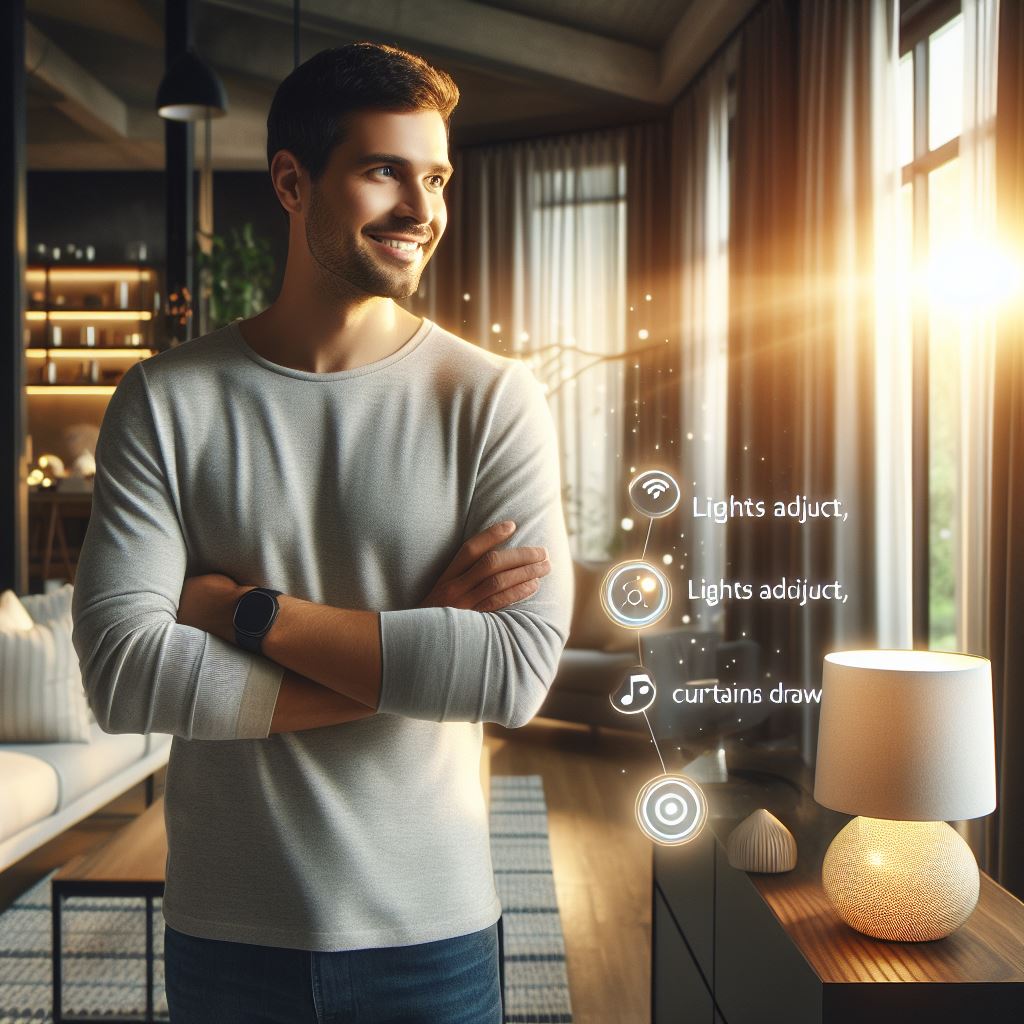Introduction
Voice assistants have quickly gained popularity in modern homes, transforming the way we control and manage our living spaces.
These devices, such as Amazon Echo and Google Home, offer a wide range of features and capabilities that make everyday tasks more convenient and efficient.
With a simple voice command, homeowners can control various aspects of their homes, from adjusting the temperature and turning on lights to playing music and ordering groceries.
This level of control and automation eliminates the need for manually interacting with multiple devices or using various remote controls.
Voice assistants also provide homeowners with a hands-free experience, allowing them to multitask and focus on other activities without having to physically interact with devices.
This is particularly beneficial in busy household environments, where individuals may have their hands full or are unable to navigate through complex interfaces.
Moreover, voice assistants are constantly evolving and becoming smarter, thanks to advancements in artificial intelligence and machine learning.
They can learn patterns, preferences, and behaviors of the homeowner, adapting to their needs and providing personalized recommendations.
This level of customization enhances the overall user experience and makes home control even more seamless.
In essence, voice assistants are revolutionizing home control by providing convenience and efficiency to homeowners.
These devices have become an integral part of modern homes, offering a hands-free and personalized experience.
As technology continues to advance, voice assistants will likely play an even more significant role in transforming the way we interact with our homes.
The Concept of Voice Assistants
Brief History of Voice Assistants
In recent years, voice assistants have rapidly gained popularity, but their origins can be traced back to decades ago.
IBM’s ‘Shoebox’ device, introduced in 1961, marked the beginning of voice recognition technology.
However, limited capabilities and high cost hindered their widespread adoption until the turn of the millennium.
In 2011, Apple’s Siri revolutionized voice assistance by offering a virtual personal assistant on their iPhones.
How Voice Assistants Work
Voice assistants utilize advanced natural language processing algorithms to interpret and respond to user commands.
They employ automatic speech recognition to convert spoken words into text and then analyze the text for context and intent.
Machine learning and artificial intelligence enable voice assistants to continuously improve their understanding of various accents, languages, and speech patterns.
These assistants can provide personalized responses, perform tasks, and control compatible smart home devices.
Popular Voice Assistant Devices
- Amazon Alexa: Introduced in 2014, Alexa powers Amazon Echo devices, allowing users to control smart home devices, play music, and access a wide range of services through voice commands.
- Google Assistant: Launched in 2016, Google Assistant is integrated with Google Home devices and offers voice-controlled smart home control, search queries, and personalized recommendations.
- Apple HomePod: Released in 2018, HomePod represents Apple’s voice assistant offering. It integrates with Apple’s ecosystem, provides home automation, plays music, and offers general information.
Voice assistants are also available on other platforms like Microsoft’s Cortana and Samsung’s Bixby, each with its unique features and integration capabilities.
Overall, voice assistants have come a long way since their inception and are now an integral part of our daily lives.
With continuous advancements in natural language processing and AI, voice assistants are poised to revolutionize home control for years to come.
Read: Property Management Software for Large Portfolios
Improving convenience and accessibility
Voice-Controlled Lighting: Enhancing Efficiency
In the realm of smart homes, voice-controlled lighting stands out as a beacon of convenience.
Gone are the days of fumbling for switches; a simple command suffices to illuminate or darken a room.
Picture entering your home after a long day at work, arms laden with groceries.
With a mere utterance, “Turn on the lights,” the room bathes in a warm glow, welcoming you with open arms.
Similarly, when retiring for the night, a single phrase, “Lights off,” effortlessly plunges the space into peaceful darkness, eliminating the need to traverse the room in search of switches.
This seamless integration of voice commands into lighting systems not only simplifies daily tasks but also fosters a sense of comfort and control within the home environment.
Voice-Controlled Temperature Settings: Optimal Comfort
Voice-enabled thermostats herald a new era of climate control, where temperature adjustments are as simple as voicing your preferences.
Imagine lounging on the couch, wrapped in a cozy blanket on a chilly evening.
Instead of braving the cold to adjust the thermostat, a voice command transforms the atmosphere to your desired warmth, ensuring comfort without disrupting your relaxation.
Conversely, during scorching summer days, a simple utterance prompts the air conditioning to cool the space to your liking, sparing you from the discomfort of excessive heat.
This seamless integration of voice control not only enhances comfort but also promotes energy efficiency by enabling precise temperature management tailored to individual preferences.
Voice-Controlled Smart Home Devices: Comprehensive Control
Beyond lighting and climate control, voice assistants extend their reach to encompass a myriad of smart home devices, including security systems and cameras.
Imagine overseeing your home’s security with a mere vocal directive, arming or disarming alarms and monitoring cameras with ease.
Whether you’re away on vacation or nestled in bed for the night, the ability to command your home’s security systems via voice empowers you with unparalleled peace of mind.
Moreover, integrating voice control into other smart devices, such as door locks and window sensors, further enhances safety and convenience, ensuring that your home is not only comfortable but also secure at all times.
In summary, voice-controlled lighting, temperature settings, and smart home devices epitomize the evolution of home automation, revolutionizing the way we interact with and manage our living spaces.
Through seamless integration and intuitive voice commands, these technologies offer unparalleled convenience, comfort, and security, transforming houses into truly smart homes.
Read: Big Data’s Impact on Real Estate Market Analysis
Streamlining daily tasks through voice assistants
A voice assistant is a revolutionary technology that has transformed daily life by simplifying tasks and increasing efficiency.
These virtual assistants can perform numerous functions by responding to voice commands, allowing users to multitask and save time.
Here are some ways in which voice assistants streamline daily tasks:
Managing calendars and setting reminders
Gone are the days of manually updating calendars and setting reminders on various devices.
Voice assistants enable users to effortlessly manage their schedules by simply voicing their commands.
Whether it’s scheduling meetings, appointments, or important events, voice assistants can understand and update calendars accordingly.
Creating to-do lists and shopping lists
With voice assistants, creating to-do lists and shopping lists has become a breeze.
Users can add items to their lists by just speaking out loud, eliminating the need for pen and paper or digital input.
Furthermore, this feature allows for easy accessibility and synchronization across multiple devices, ensuring that the lists are always up to date.
Getting weather updates and news briefings
Keeping up with the latest weather forecast or staying informed about current events is effortless with voice assistants.
By simply asking for weather updates or news briefings, users can receive real-time information without having to navigate through various apps or websites.
This feature is particularly useful for those with busy schedules who need quick and reliable updates.
Ordering items through online shopping platforms
Voice assistants have revolutionized the online shopping experience by allowing users to make purchases through voice commands.
Whether it’s groceries, home essentials, or even clothing, users can simply instruct their voice assistants to order items from their preferred online shopping platforms.
This streamlined process eliminates the need for manual browsing and input, making online shopping more convenient than ever.
In short, voice assistants have proven to be a game-changer when it comes to streamlining daily tasks.
By managing calendars, creating lists, providing weather updates, and facilitating online shopping, these virtual assistants have become invaluable tools in enhancing productivity and simplifying everyday life.
Incorporating a voice assistant into your home control system can revolutionize the way you manage your tasks and ultimately lead to a more efficient and organized lifestyle.
Enhanced entertainment options
With these advancements in home control, voice assistants are revolutionizing the entertainment options available to homeowners.
Whether it’s playing music, accessing streaming services, controlling audio equipment, or integrating with smart TVs and gaming consoles, voice assistants offer a convenient and hands-free experience.
Playing music and podcasts
Playing music and podcasts has never been easier.
Instead of manually searching for your favorite songs or podcasts, simply ask your voice assistant to play them, and they’ll start playing instantly.
Whether you’re hosting a party or relaxing at home, your voice assistant can set the mood with the perfect playlist.
Accessing content on streaming services (Netflix, Hulu, etc.)
Streaming services have quickly become a staple in many households. With voice assistants, you can access these platforms with ease.
Say goodbye to scrolling through endless menus and searching for shows and movies on your own.
Simply ask your voice assistant to play your desired content, and it will do the rest.
Controlling home theater systems and audio equipment
Controlling home theater systems and audio equipment can be a hassle, especially with multiple remotes and complex setups.
Voice assistants simplify this process by allowing you to control everything with your voice.
Adjust the volume, change the channel, or switch inputs effortlessly, all while sitting comfortably on your couch.
Integrating with smart TVs and gaming consoles
Smart TVs and gaming consoles are becoming more prevalent in households.
Voice assistants can seamlessly integrate with these devices, providing a hands-free experience.
Control your TV settings, navigate through apps, and even launch your favorite games, all through voice commands.
In general, voice assistants have revolutionized home control, particularly in the area of entertainment.
Through voice commands, homeowners can easily play music and podcasts, access streaming services, control home theater systems and audio equipment, and integrate with smart TVs and gaming consoles.
These enhanced entertainment options have made life more convenient and enjoyable for homeowners everywhere.
Read: Data Analytics: Transforming Loan Assessment

Voice assistants for home security
With the advancements in technology, voice assistants have now become a revolutionary tool for controlling various aspects of our homes.
One major area where voice assistants have had a significant impact is home security.
Monitoring security cameras and alarms through voice commands
Gone are the days when you had to rely on complex interfaces to monitor your home security cameras and alarms.
Voice assistants have made it easier than ever before to keep an eye on your property.
Using voice commands, you can now ask your voice assistant to show you live feeds from your security cameras or check the status of your alarms.
This functionality not only provides convenience but also enhances the overall security of your home.
Locking and unlocking doors remotely with voice control
Another fascinating feature offered by voice assistants is the ability to control and manage the security of your doors remotely.
With a simple voice command, you can lock or unlock your doors without even lifting a finger.
This feature comes in handy in various situations, such as when you forget to lock your doors before leaving the house or when you want to grant access to someone while you’re away.
Voice-controlled door locks provide an extra layer of convenience and security.
Notifying homeowners of suspicious activities or breaches
Voice assistants also play a crucial role in notifying homeowners of any suspicious activities or breaches in their home security systems.
They can send instant alerts and real-time notifications to keep homeowners informed about potential threats.
Whether it’s a motion detected on a security camera or an unauthorized entry attempt, voice assistants can quickly inform homeowners and provide options for further action.
This proactive approach to home security gives homeowners peace of mind and allows them to take necessary steps to ensure their safety.
Overall, voice assistants have revolutionized home control, particularly when it comes to security.
The ability to monitor security cameras, control door locks, and receive notifications through simple voice commands has transformed the way we protect our homes.
As technology continues to evolve, we can only expect voice assistants to become even more advanced and integral to our daily lives.
The convenience, efficiency, and enhanced security they provide make voice assistants an essential tool for any homeowner concerned about their home’s safety.
Read: Virtual Reality Tours: Financing Implications
Challenges and Limitations of Voice Assistants
Privacy Concerns Regarding Always-On Listening Devices
With voice assistants constantly listening, there are valid concerns about privacy and potential invasions of personal space.
Users worry that their conversations may be captured and used for targeted advertisements or even shared with third parties without their consent.
Data breaches and hacks targeting voice assistant platforms also pose a significant threat to users’ privacy.
While companies like Amazon and Google claim to prioritize user privacy, trust in these assurances remains a challenge.
Striking the delicate balance between convenience and privacy is a complex issue that requires ongoing scrutiny and regulation.
Potential Issues with Voice Recognition Accuracy
One of the biggest challenges faced by voice assistants is maintaining a high level of accuracy in recognizing voice commands.
Accents, speech impediments, and background noise can all affect voice recognition, leading to frustration for users.
Misinterpretations or false positives can result in unintended actions, potentially compromising the user experience and causing inconvenience.
As voice assistants continue to improve, advancements in Natural Language Processing and machine learning algorithms are needed to enhance accuracy.
Ongoing user feedback and regular updates are crucial for voice assistants to better understand and respond to user commands.
Integration Limitations with Certain Devices or Platforms
Although voice assistants offer seamless control over various smart devices, integration limitations still exist.
Compatibility issues can arise when attempting to connect voice assistants with older or less popular devices.
Some platforms may have exclusive partnerships with specific voice assistants, restricting choices for users.
Lack of support for certain languages or regions further hinders the widespread adoption and usability of voice assistants.
Continued efforts to expand integration options and broaden compatibility will improve the overall user experience.
In review, voice assistants revolutionize home control but come with their set of challenges and limitations.
Privacy concerns demand increased transparency, stringent safeguards, and improved user control over data collection.
Voice recognition accuracy remains an ongoing challenge, requiring advancements in technology and regular updates.
Integration limitations hinder the seamless control of certain devices and platforms, calling for enhanced compatibility efforts.
Addressing these challenges will ensure that voice assistants continue to evolve and fulfill their potential in revolutionizing home control.
Future trends and possibilities
Advancements in natural language processing and artificial intelligence
The future of voice assistants lies in continuous advancements in natural language processing (NLP) and artificial intelligence (AI).
NLP enables voice assistants to understand and interpret complex human language, making interactions more seamless.
AI algorithms continuously learn and improve, allowing voice assistants to provide more accurate and relevant responses.
These advancements will enable voice assistants to understand context, tone, and even emotions, making interactions more human-like.
Integration with smart appliances and IoT devices
Voice assistants are moving beyond controlling basic home functions and are integrating with smart appliances and IoT devices.
Users can now control their thermostats, lights, and even kitchen appliances with voice commands.
Integration with IoT devices allows for a more connected and automated home, enhancing convenience and efficiency.
In the future, voice assistants will continue to expand their compatibility, enabling users to control a wider range of devices.
Voice assistants as personalized assistants, learning user preferences
Voice assistants are becoming personalized assistants, learning user preferences to provide tailored experiences.
They can remember music preferences, preferred temperature settings, and even preferred recipes.
Voice assistants can anticipate user needs and offer suggestions based on previous interactions.
This level of personalization enhances user experience and saves time and effort.
In the future, voice assistants will further improve their ability to understand and cater to individual preferences.
Future trends and possibilities for voice assistants are promising.
Advancements in NLP and AI will make interactions more human-like, while integration with smart appliances and IoT devices will enhance home control.
Furthermore, voice assistants will become more personalized, learning and anticipating user preferences.
With these developments, voice assistants will play an even more significant role in revolutionizing home control.
Conclusion
Voice assistants provide convenience, efficiency, and hands-free control over various smart home devices.
They simplify tasks like adjusting temperature, controlling lighting, playing music, and managing daily schedules.
Voice assistants also enhance accessibility for individuals with disabilities, allowing them to interact with their homes effortlessly.
Incorporating voice assistants into our lives can vastly improve our daily routines and streamline our home control systems.
It is essential to keep an open mind, experiment with different voice assistant platforms, and adapt to their ever-expanding capabilities.
By exploring and embracing voice assistant technology, we can revolutionize the way we interact with our homes and make everyday tasks more convenient.
Voice assistants are revolutionizing home control, creating a future where smart homes become more intuitive and effortless to manage.
With voice command capabilities, our homes will transform into personalized, intelligent spaces tailored to our needs.
The impact of voice assistants extends beyond just home control, as they contribute to a more connected and efficient lifestyle overall.
Voice assistants have emerged as game-changers in revolutionizing home control.
Their ability to understand and respond to voice commands allows for seamless integration between humans and technology.
By embracing the convenience and efficiency brought by voice assistant technology, we can optimize our lives and experience a new level of smart home control.




